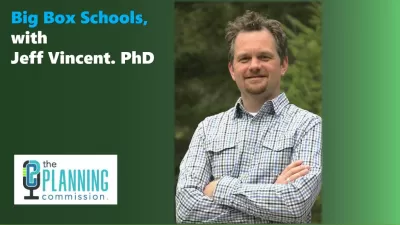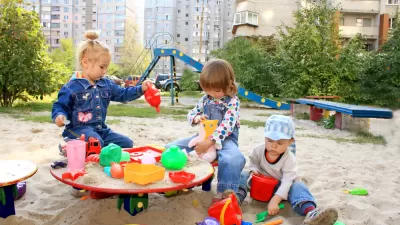Urban Planning is rarely seen as a remedy for the state of the education system. However, thoughtful community design that integrates schools in new ways can lead to successful learning environments and vibrant communities.
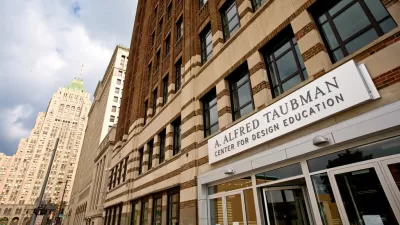
“It takes a village to raise a child.” Most people believe this adage, but is it still valid today? Can its suggestion of small, rural communities collectively raising their children apply to today’s urban environments? A hundred years of city planning concepts and zoning regulations that have successfully isolated schools from communities would seem to say no. But a growing number of forward‐thinking educators and business people are discovering clever ways of recreating the village ethos within their cities, and finding that it may indeed help to have a village to raise a child.
A non‐traditional way of integrating education with the community and avoiding the isolated school campus is “Mixed‐Use Education,” which physically and programmatically combines schools with non‐ educational uses. Mixed‐use urban planning that combines entertainment, commercial, and residential uses has proven successful in creating more vibrant communities, but rarely have educational facilities been included in the mix. This is partly the result of zoning requirements in some cities, and partly due to traditional thinking that schools shouldn’t mix with other community functions. However, there is compelling evidence that cities, educators, planners, and communities should review their zoning laws and their thinking to promote Mixed‐Use Education.
Enjoy life‐long learning across generations
When the owner of the Grace Living Center in Jenks, Oklahoma, saw how the elderly residents seemed happier while watching children playing across the street from the home, he had an idea for a new type of integrated facility. He invested $200,000 for the construction of two classrooms inside the nursing home, and arranged with the school district to rent the spaces out as a kindergarten for a $1 annual fee.
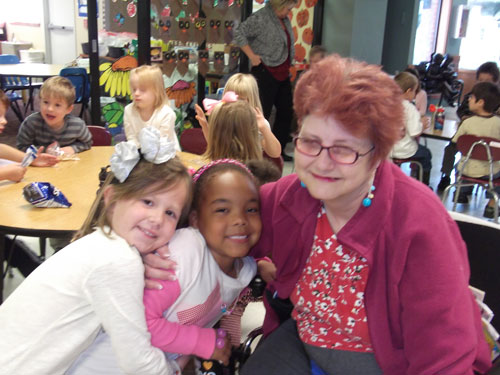
This simple program has achieved astounding results: Children and elder residents share space and activities. They read to each other, talk about their lives growing up in Oklahoma, and practice arts and improvisational acting. Through their regular interaction with the children, the elders are happier, healthier, and more optimistic. In his book The Element, Ken Robinson describes how medication levels dropped at Grace Living Center and how reading skills among the children improved to a third grade level or higher. The children tend to be more emotionally mature as they learn responsibility, self‐discipline, tolerance, and the acceptance of differences in their contact with the residents.
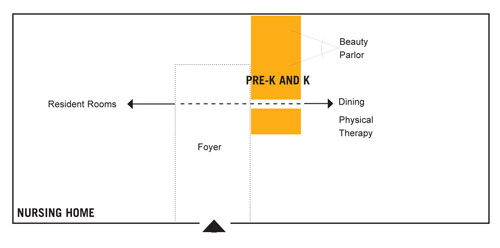
What makes this model of life‐long learning across generations so successful? Thoughtful colocation and the resulting opportunities for continuous interaction are important factors. The classrooms are placed in the center of the senior home’s lobby. Partial‐height, transparent walls lightly enclose the teaching spaces to allow the activities to be seen from the lobby and the children’s voices and laughter to be heard throughout the building. Even residents who are not participating in activities can enjoy the children’s uplifting presence. They pass the area three or more times a day on their way to their meals or to physical therapy. Their beauty parlor looks directly into the classrooms.
The benefits of this combination of uses extend beyond the children and elders to the immediate community. Parents are so pleased with the school that a lottery is required to enter. Teachers enjoy seeing children and elders grow and learn together. “The Grace Living Center has no problem with staff turnover, in an industry plagued with staffing shortages,” stated owner Don Greiner in a CNN interview. The idea of combining the kindergarten and the senior home turned out to be a clear win‐win: The nursing home owners’ hope for happier seniors was fulfilled and the school district’s financial gain was unexpectedly outdone by its academic success.
Build talent through direct and continuous interaction
How important is the sharing of physical space, beyond convenience and financial advantages, to the success of these types of programs? Could a successful partnership happen remotely or through field trips? If you ask Aviation High School’s leadership, you will hear a clear “no.”
Aviation High School in Seattle, Washington, collaborates closely with mentors from the nearby aviation and aerospace industry. Students learn, explore, and sometimes even compete with their mentors to solve engineering problems. The engineers are central to the curriculum in sharing their technical expertise and their career pathways.
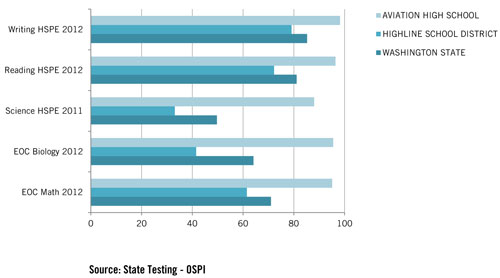
The success of this partnership is unparalleled: Known for technical excellence and entrepreneurial leadership, Aviation High School outperforms most high schools district and statewide in test scores. The students are not the only beneficiaries of this unique collaboration. Their mentors are inspired by the students’ energy and creativity, and have a talent pool of bright interns and potential future employees to draw from.
A new campus, slated to open later this year, is adjacent to the Boeing Fields and the Museum of Flight. In the midst of hundreds of aviation‐related enterprises, this location allows for an intense and continuous exchange between mentors and students. This deliberate move reflects the leadership’s belief that the school needs to be in the Boeing Field vicinity to fully realize its vision and mission.
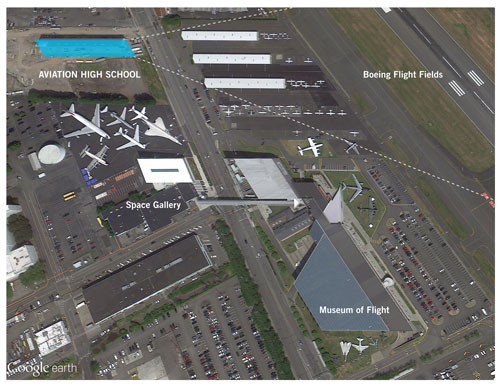
The new building looks out toward Boeing Field, with its frequent takeoffs and landings, emphasizing how the direct environment motivates learning. The school’s labs on the ground floor similarly draw aviation‐themed inspiration from their surroundings as they open directly to the Museum of Flight’s Airpark, which features the first 747, a Concorde, and a Lockheed Super‐G Constellation. Students will have free access to the exhibits and the expertise of the museum’s staff, while the museum enjoys the students’ creative help with exhibits and programs.
Encourage imaginative thinking in an inspiring and relevant context
Aviation High School offers an inspiring environment for fostering creativity in technically inclined students and their mentors. Progressive educators and business leaders see creativity as one of the most important 21st century skills and consider its support essential in driving innovation. Enterprising schools recognize the role of the physical environment in achieving this.
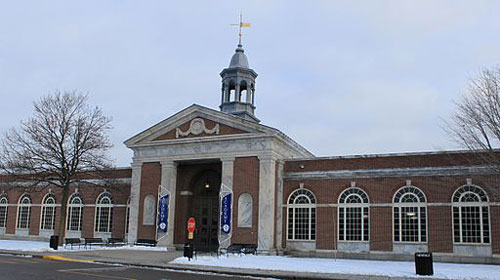
In Dearborn, Michigan, a top‐performing college‐prep high school is benefitting from its relationship with the Ford Motor Company. The Henry Ford Academy is located in the Henry Ford museum with its classrooms near Buckminster Fuller’s iconic Dymaxion House. Several times a week, the students visit the exhibits to study, sketch, and write about what they see. Regular exposure to an environment rich with culture and content supports the school’s “Design Thinking” curriculum, a program that teaches students to think like designers by creatively solving problems.
The Henry Ford Learning Institute’s School for Creative Studies in Detroit is similarly placed in a mixed‐use environment, sharing space with the College for Creative Studies in a beautifully renovated historic building in the city's museum district. Students learn alongside college role models who are preparing for careers in creative professions. Beyond emphasizing readiness for college and careers, the school uses community‐based design challenges to prepare students in becoming active agents in community redevelopment.
The locations of the Henry Ford educational facilities mirror the organization’s view that education reform cannot take place within an educational system that isolates students and teachers from their communities and separates teaching and learning from the world around them.
Immerse future citizens in environmental stewardship
Students often complain that their learning experiences are not relevant to their lives. Research shows that if the applicability of the learning material becomes apparent to students, their motivation to learn increases and their goals are more likely to be attained. Innovative schools are discovering that integrating living and learning, and locating schools where students can enjoy real‐life experiences, can be highly beneficial.
The Zoo Magnet Center in Los Angeles’s Griffith Park opens out on a living laboratory that includes the Los Angeles Zoo, the Botanical Gardens, and the L.A. River ecosystem. The high school’s partnership with the Zoo and the park district gives students not only the opportunity to study, but also to practice wildlife conservation, animal care, biology, chemistry, and environmental stewardship on site. It teaches responsible behavior towards an environment with limited resources.
The school’s location in Griffith Park, the nation’s largest municipal park with an urban wilderness area, and next to the Zoo is important for the curriculum’s success. It promotes interaction with wildlife and endangered species, and allows for intensified stimuli and a more profound understanding of the ties between the environment and future generations.
Make education an integral part of our daily lives
It might not take a village to raise a child, but learning can become more effective when the teachers include diverse members of the community, and when the environment itself becomes a teacher. Our society has traditionally addressed educational questions in isolation. How can we improve test scores at schools? What can we do to raise the next generation of innovators? How do we invigorate workplaces? What should elder care look like? How can we protect the environment? How do we address budget cuts?
Successful mixed‐use education models simultaneously solve multiple questions in inspiring ways. The way we plan our cities can enable that. School districts, along with city planners and architects, too often limit themselves to the physical setting of the campus. But education cannot be restricted to a campus. It should be an integral part of our daily lives. Moving away from traditional approaches to education and encouraging the interaction, mentorship, and partnerships that Mixed‐Use Education allows can help create happy, generous, smart, creative, innovative and sustainable communities. This type of holistic thinking is best summarized by architect Christopher Alexander in his book, “A Pattern Language”:
When you build a thing you cannot merely build that thing in isolation, but must also repair the world around it, and within it, so that the larger world at that one place becomes more coherent, and more whole; and the thing which you make takes its place in the web of nature, as you make it.
Tinka Rogic is an architect and K-12 researcher with Perkins+Will, Los Angeles. She studies innovative learning environments with a focus on city planning, learning sciences and new technologies.
Further Reading
Milton Chen: “Education Nation: Six Leading Edges of Innovation in our Schools”, Wiley Imprint
Ken Robinson: “The Element: How Finding Your Passion Changes Everything”, Penguin Books
Lisa Morehouse: “Senior Citizens Help Young Children with Reading ‐‐ and Relationships”, Edutopia
Reba Gilman: “Going Sky High: Students Take Learning to New Levels”, Edutopia

Maui's Vacation Rental Debate Turns Ugly
Verbal attacks, misinformation campaigns and fistfights plague a high-stakes debate to convert thousands of vacation rentals into long-term housing.

Planetizen Federal Action Tracker
A weekly monitor of how Trump’s orders and actions are impacting planners and planning in America.

San Francisco Suspends Traffic Calming Amidst Record Deaths
Citing “a challenging fiscal landscape,” the city will cease the program on the heels of 42 traffic deaths, including 24 pedestrians.

Half of Post-Fire Altadena Home Sales Were to Corporations
Large investors are quietly buying up dozens of properties in Altadena, California, where a devastating wildfire destroyed more than 6,000 homes in January.

Opinion: What San Francisco’s Proposed ‘Family Zoning’ Could Really Mean
Mayor Lurie is using ‘family zoning’ to encourage denser development and upzoning — but could the concept actually foster community and more human-scale public spaces?

Jacksonville Launches First Autonomous Transit Shuttle in US
A fleet of 14 fully autonomous vehicles will serve a 3.5-mile downtown Jacksonville route with 12 stops.
Urban Design for Planners 1: Software Tools
This six-course series explores essential urban design concepts using open source software and equips planners with the tools they need to participate fully in the urban design process.
Planning for Universal Design
Learn the tools for implementing Universal Design in planning regulations.
Gallatin County Department of Planning & Community Development
Heyer Gruel & Associates PA
JM Goldson LLC
City of Camden Redevelopment Agency
City of Astoria
Transportation Research & Education Center (TREC) at Portland State University
Jefferson Parish Government
Camden Redevelopment Agency
City of Claremont


























